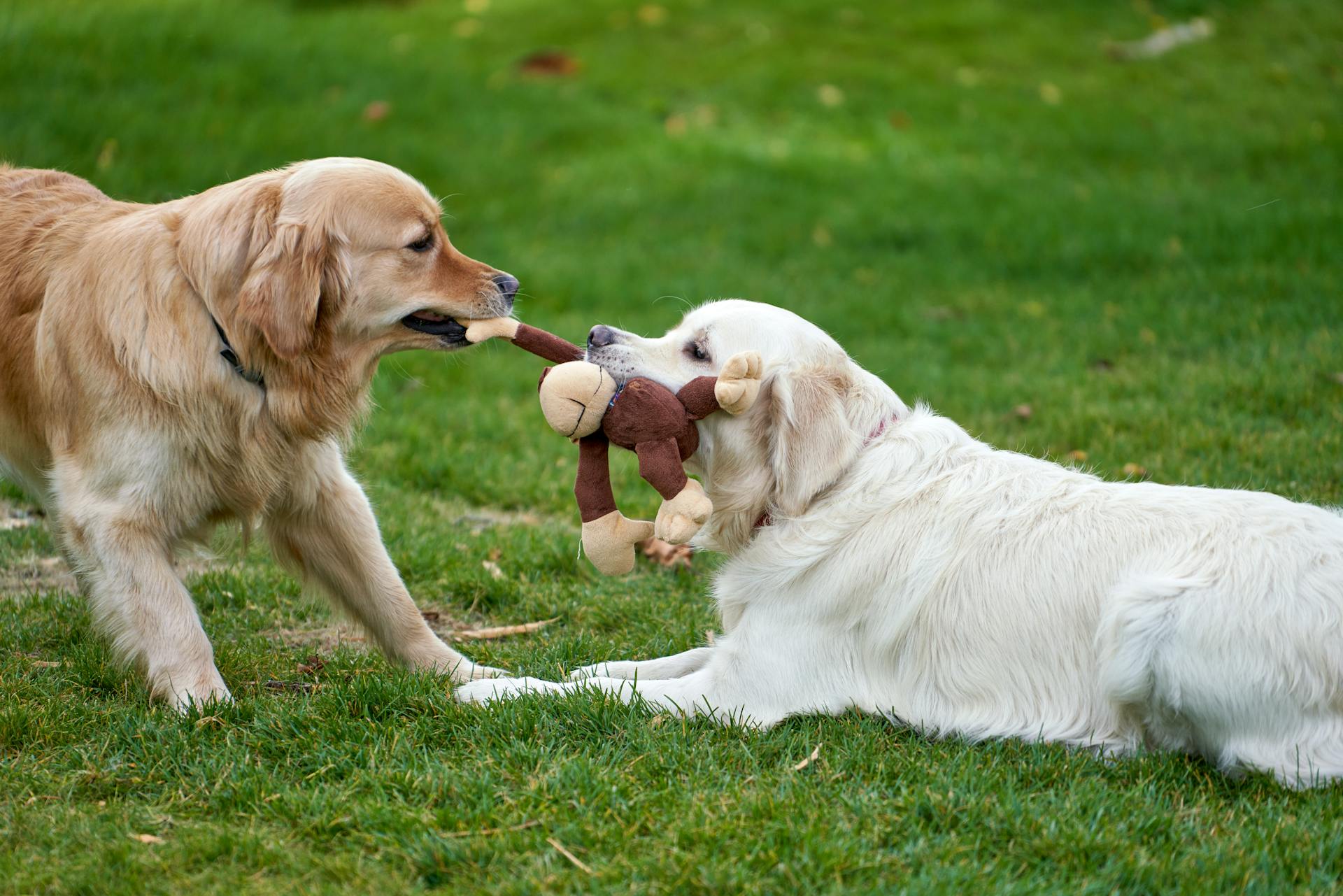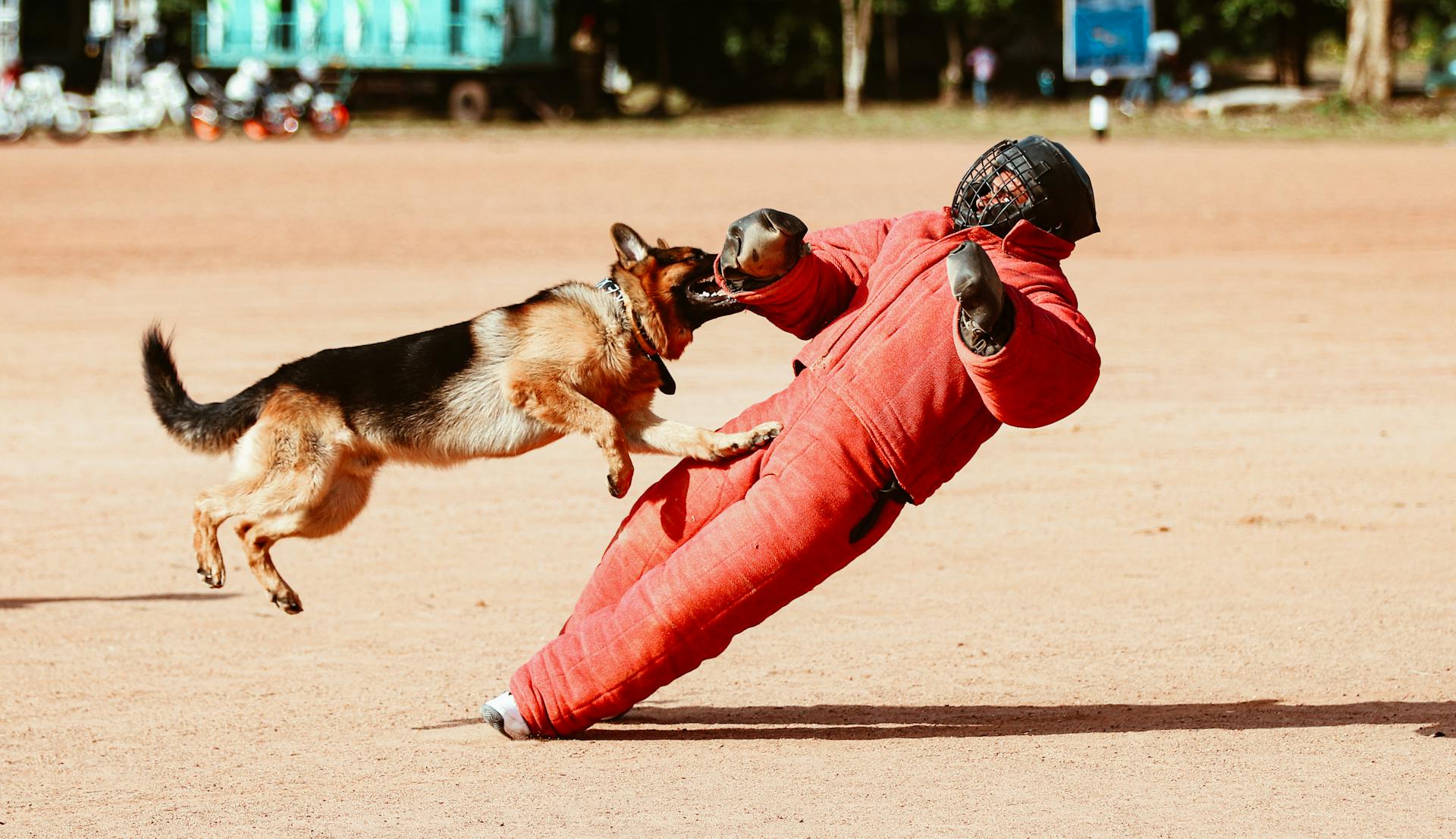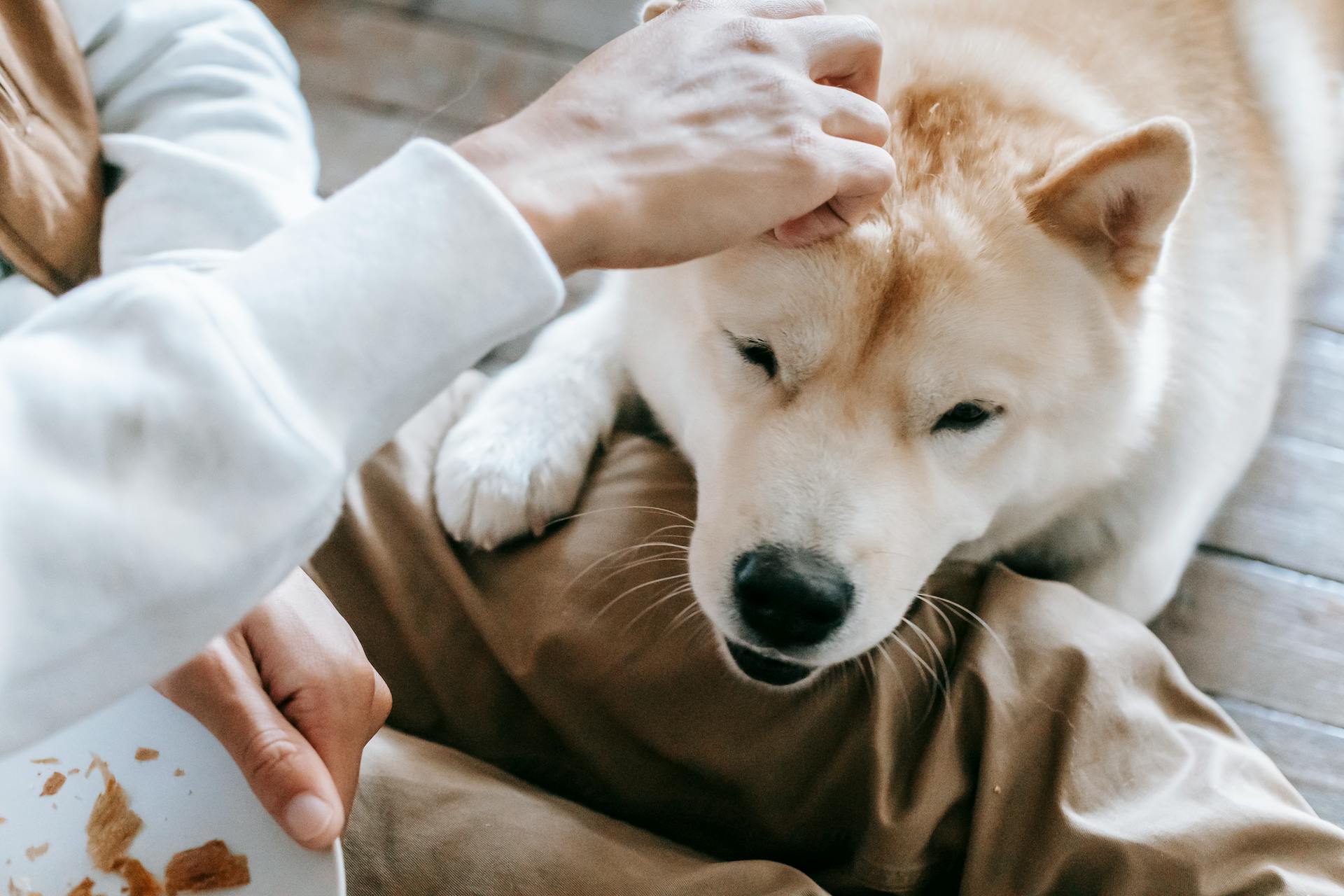
Dogs can become aggressive when they sense fear in their owners or others because they're wired to protect their pack. This instinctual behavior can be triggered by a variety of factors.
A key factor is that dogs are highly attuned to body language and pheromones, which are chemical signals that convey emotions. When they pick up on fear pheromones, it can cause them to become defensive and even aggressive.
Dogs often look to their owners for cues on how to behave, so if they sense fear in their owner, they may become more alert and protective. This can create a vicious cycle where the dog becomes more aggressive, which in turn causes the owner to become more fearful.
To break this cycle, it's essential to recognize and manage your own fear around dogs. By remaining calm and assertive, you can help your dog feel more secure and reduce the likelihood of an attack.
Explore further: Dogs Sense Evil
Causes of Fear Aggression
Fear aggression in dogs is often a result of traumatic past experiences, such as abuse, abandonment, or negative encounters. These experiences can lead to a dog developing fear as a defence mechanism.
A dog's perception of a threat can be real or perceived, and it may show aggression as a form of self-defence. This type of aggression is typically an overexaggerated response to a perceived threat.
Environmental factors, such as sudden changes or lack of early socialisation, can also trigger fear aggression in dogs. This can be especially true if a dog has not been properly socialised to new people, places, and experiences.
Traumatic past experiences can have a lasting impact on a dog's behaviour, leading to fear aggression. In many cases, a dog may learn that aggression is an effective strategy for dealing with threats.
A dog's genetic makeup can also play a role in its behaviour, but fear aggression is usually a learned behaviour. This means that a dog's environment and experiences can shape its behaviour, rather than its genetic predisposition.
You might like: What to Do for Your Dog's Birthday?
Here are some common causes of fear aggression in dogs:
- Abuse or negative experiences
- Abandonment or lack of care
- Sudden changes or environmental stressors
- Lack of early socialisation
These causes can lead to a dog developing fear aggression, making it essential for pet owners to understand and address the issue to ensure the well-being of both the dog and those around it.
Recognizing Fear Aggression
Recognizing fear aggression in dogs can be a challenge, but there are some key signs to look out for. A fearful or aggressive dog may adopt a low body posture, with its tail tucked between its legs and ears pinned back against the head.
Some dogs may display more subtle signs of fear, such as excessive lip licking and yawning, which can precede fear aggression. These behaviors can be indicative of stress or anxiety, so it's essential to be aware of them.
A clear signal that a dog is uncomfortable and may react aggressively if pushed further is baring its teeth. This is a common warning sign that should not be ignored.
Signs and Symptoms
Recognizing fear aggression in dogs can be a challenge, but being aware of the warning signs can help you defuse situations before they escalate.
Growling, barking, and baring teeth are common signs of a fear-aggressive dog, but there are also more subtle signs to look out for.
Excessive lip licking and yawning can be signs of stress or anxiety, which may precede fear aggression.
If you notice your dog exhibiting any of these behaviors, it's essential to take a step back and assess the situation to prevent things from getting out of hand.
Here are some specific signs to watch out for:
- Growling
- Barking
- Baring teeth
- Snapping
- Biting
- Excessive lip licking
- Yawning
These signs may seem minor, but they can be indicative of a deeper issue, so it's crucial to address them promptly.
Posture
Recognizing fear aggression in dogs can be a challenging task, but there are some clear signs to look out for.
A fearful or aggressive dog may adopt a low body posture, with its tail tucked between its legs and ears pinned back against the head.
This low body posture is a common indicator of fear or aggression in dogs, and it's essential to recognize it before the situation escalates.
If you notice a dog with its ears pinned back and tail tucked in, it's best to give it space and let it come to you.
This low body posture can be a clear warning sign that a dog is feeling uncomfortable or threatened, so it's crucial to respect its boundaries.
Here are some common signs of a fearful or aggressive dog's low body posture:
- Tail tucked between the legs
- Ears pinned back against the head
Growling and Snarling
Growling and snarling are clear warning signs that a dog is feeling threatened and may become aggressive. These behaviors are often a last resort for a fearful dog.
A fearful dog may display these warning signs without necessarily intending to cause harm, but rather as a form of self-defence. This is a key distinction to make when recognizing fear aggression.
Growling and snarling can be subtle or overt, and it's essential to pay attention to these cues to defuse situations before they escalate. A fearful dog may not always give a clear warning sign before striking.
Consider reading: Doberman Pinscher Snarling
Here are some key points to remember about growling and snarling in fearful dogs:
- These are warning signs that a dog is feeling threatened and may become aggressive.
- A fearful dog may not always give a clear warning sign before striking.
- These behaviors are often a last resort for a fearful dog.
By recognizing these warning signs, you can take steps to prevent fear aggression and keep yourself and others safe.
Managing Fear Aggression
Managing fear aggression in dogs requires a multi-faceted approach that addresses the root causes of this behavior. Understanding that fear aggression is a defensive reaction to a perceived threat is crucial in developing effective strategies to manage it.
To prevent aggressive incidents, it's essential to identify and mitigate your dog's aggression triggers. This can be achieved by avoiding triggers or slowly desensitizing your dog to them through a proactive approach.
Desensitization methods, such as counter-conditioning, can be effective in changing a dog's emotional response to fear stimuli. This process involves gradually and safely exposing the fearful dog to the fear source in a controlled manner, aiming to replace their fear response with a more desirable behavior.
Additional reading: What to Do with Your Dog's Ashes?
Regular training is a cornerstone in the management of fear aggression. Training sessions provide an opportunity to reinforce desired behaviors and work through problematic reactions in a controlled setting.
Some strategies for managing fear aggression include:
- Counter-conditioning and desensitization methods
- Changing the dog's emotional response to fear stimuli
- Identifying and mitigating your dog's aggression triggers
- Regular training to reinforce positive behavior
Safety measures, such as muzzle training, avoidance tactics, and loose lead practices, are also essential in preventing situations that may lead to dog bites or other aggressive behaviors.
Preventing Aggressive Incidents
Preventing Aggressive Incidents is key to reducing the likelihood of your dog attacking when they sense fear. Identifying and mitigating your dog's aggression triggers is a significant first step in prevention.
Understanding what triggers your dog's fear aggression is crucial. By avoiding these triggers, or slowly desensitizing your dog to them, you can minimize the chances of aggressive behaviours or encounters.
A proactive approach in desensitisation is often more effective than trying to manage aggression once it has occurred. This approach emphasizes the importance of prevention over cure.
To prevent aggressive incidents, you should:
- Identify and avoid your dog's aggression triggers
- Slowly desensitize your dog to these triggers through a controlled process
Structured socialisation can also be immensely beneficial in preventing aggressive incidents. This involves organizing meet-and-greets with other dogs in neutral, controlled settings, starting with both dogs on-leash to ensure safety.
Common Misconceptions
Dogs don't attack because of how they're raised alone, genetics and past traumas also play a significant role.
Upbringing is just one piece of the puzzle, and it's not the only factor that determines a dog's behavior.
Breed-specific aggression is a common myth, but it's not a reliable indicator of a dog's likelihood to attack when it senses fear.
Here are some common misconceptions about fear aggression:
- Breed-specific aggression
- “Alpha” dominance theory
While the "alpha" dominance theory may have been popular in the past, it's been largely discredited by experts, and there's no scientific evidence to support it.
Myths and Misconceptions
Upbringing plays a significant role in shaping a dog's behavior, but it's not the only factor at play. Genetics and past traumas also contribute to aggressive behavior in dogs.

Breed-specific aggression is a common misconception - different breeds don't inherently have more aggressive tendencies than others. However, some breeds may be more prone to certain types of aggression due to their breeding history.
The idea that certain breeds are naturally more aggressive than others is a myth that's been debunked. In reality, aggression is a complex issue that's influenced by a combination of genetic and environmental factors.
The "alpha" dominance theory is another myth that's been widely discredited. This theory suggests that dogs establish a strict hierarchy with a dominant leader, but research has shown that this simply isn't how dogs behave in the wild.
Encouraging the Behavior
Dogs can get insecure and try to overcompensate by attacking someone they feel is weaker, often due to a lack of proper training or experience with people or other dogs.
Their natural instinct to maintain their pack as strong as possible can also lead to aggressive behavior, especially in wild dogs or their relatives.
A dog's body language can be a clear indicator of aggression - if you notice a dog that's very still and rigid, with its ears back and teeth showing, it's best to exercise caution.
Dogs that are aggressive can be unpredictable, so it's essential to be aware of the signs and take necessary precautions to stay safe.
Frequently Asked Questions
What do dogs do when they sense your fear?
Dogs may exhibit fear-based reactions when sensing fear in humans, mirroring their owner's emotions through behavior and body language
Sources
- https://www.rileysplace.org/dogblog/understanding-dog-bite-behavior-or-dont-blame-the-dog-when-it-bites/
- https://www.dvm360.com/view/forget-dominance-fear-based-aggression-dogs
- https://www.thecynophobiaclinic.com.au/blog/can-dogs-smell-my-fear-how-dogs-react-when-youre-afraid-of-them/
- https://cbtdogbehaviour.com/fear-aggression-in-dogs/
- https://wagwalking.com/behavior/why-do-dogs-attack-when-they-sense-fear
Featured Images: pexels.com


